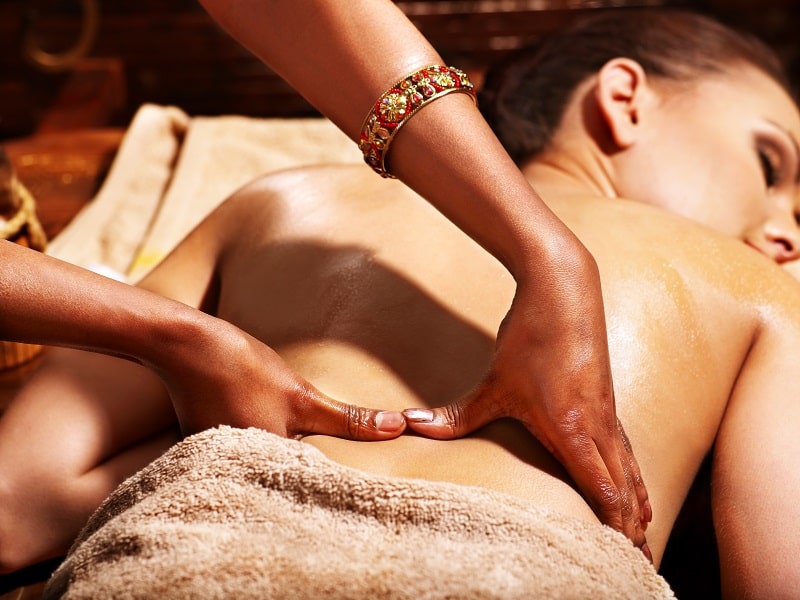Abhyanga is now also known with the name – ‘Ayurvedic Body Massage’. In addition to its moisturizing effects, it also has therapeutic benefits. According to Ayurvedic Science, it reduces alleviates Vata aggravation and reduces physical fatigue and mental stress. It improves flexibility and promotes suppleness. It also improves the skin health and makes it delicate, soft and tender, but strong. It has rejuvenating effects, which improves lifespan and reduces the signs of aging. All of its beneficial effects are attributed to its effects on blood circulation and relaxation. It increases blood circulation and induces deep relaxation, which is ultimately helpful in a number of diseases.
What Is Abhyanga?
In the classics of Ayurveda, different forms of massages are mentioned as per the requirement and method. According to Ayurveda, Abhyanga is one among the Daily Regimen (Dinacharya), which is also a part of pre-therapeutic procedures of Panchakarma.
The word ‘Abhyanga’ is derived from the Sanskrit word ‘Anga’ meaning body parts and ‘Abhaya’, the prefix meaning fearless or strong. It is a part of Ayurvedic Therapy called Snehana (Ayurvedic Oleation Therapy).
Abhyanga is specially designed for individuals who need positive health and wish to prevent and cure diseases. Abhyanga slows down aging, improves vision clarity, promotes longevity, boosts good skin, improves sleep cycle and overcomes fatigue.
In a nutshell, Abhyanga eliminates the effects of aggravated vata dosha and nourishes the entire body. This massage should be performed regularly over the whole body, including the head, ear and soles for best results.
How Ayurvedic Massage works?
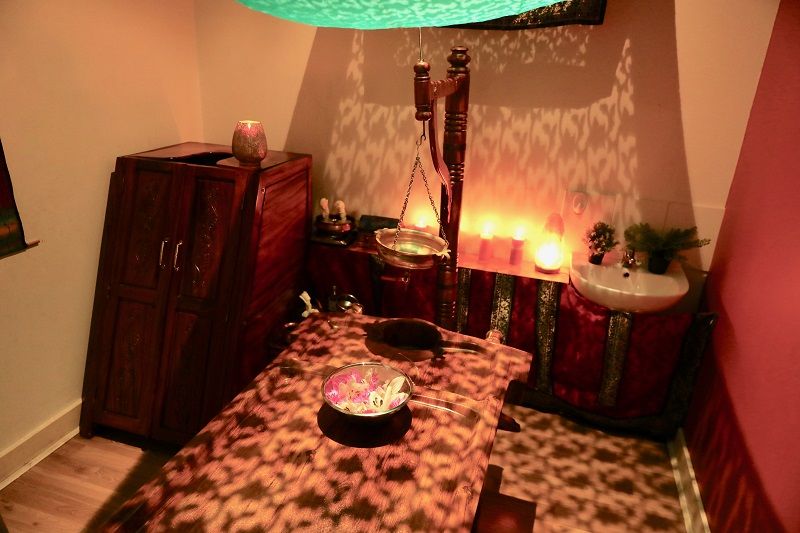
Abhyanga if followed daily has the ability to nourish the body tissues, provide strength and increase the Agni (digestion and metabolism).
Studies have found that oil used during the massage penetrates deep into the seven layers of the skin. The oil first reaches the hair follicles and then the skin.
According to ayurveda, after absorption of oil into the skin, it reaches the red blood cells (Rakta Dhatu) followed by the flesh or muscles of the body (Mamsa Dhatu) and then the fat tissue (Medo Dhatu), then the bone tissue layer (Asthi Dhatu) and finally the nerves (Majja Dhatu).
Because it reaches so deep into the skin, it strengthens each layer as well as detoxifies it. Massaging the soles of the feet is a key to the healthy lifestyle.
The soles of the feet have Marma points, which stimulate the sense organs. This improves the functioning of the sense organs, which boosts health as a whole. This, in turn, improves the overall health of the body.
Benefits of Full Body Ayurvedic Massage
Relieves Stress
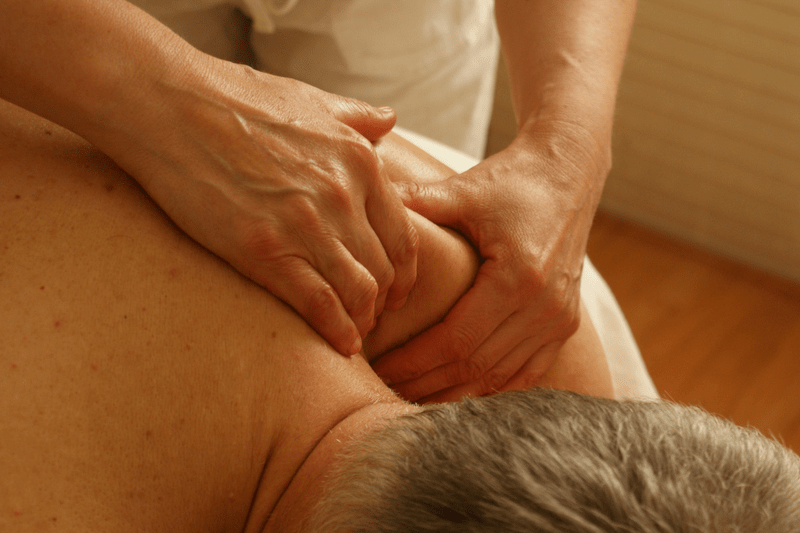
Stress and health are inter-linked. Stress often causes disorders of the mind and the body. Abhyanga is an Ayurvedic approach adopted for relaxation and to relieve stress.
Abhyanga has a soothing effect on the nervous system, that is governed by the Vata Dosha. After the massage, the level of an amino acid tryptophan increases in the blood. Tryptophan then gets converted to serotonin in the body, which is also known as a ‘happy hormone’.
Serotonin induces a feeling of happiness, overall well-being and uplifts the mood.
Studies have observed that pada Abhyanga or foot massages reduce stress, agitation and behavioral problems in older individuals with dementia.
One study concluded that slow stroke back massage and hand massage promotes relaxation and relieves stress.
Boosts Immune System
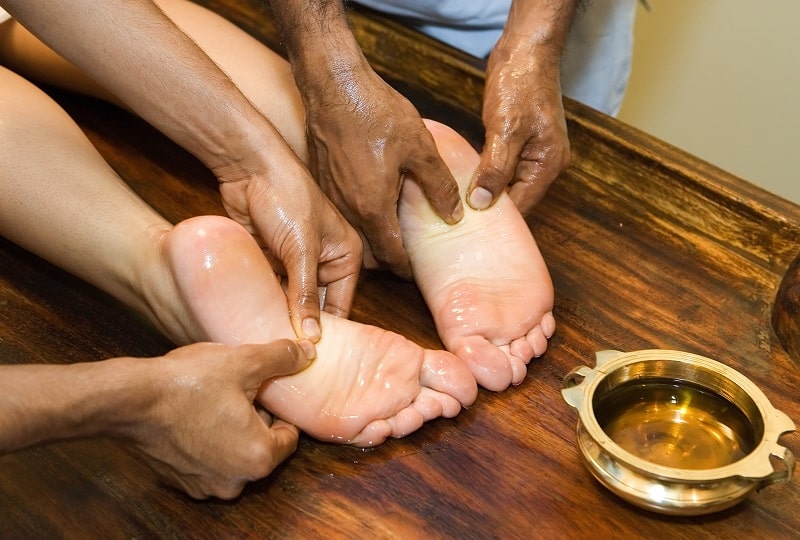
Having a poor immune system puts you at an increased risk of infections and diseases. Regular full body ayurvedic massage can enhance the immune system and reduce the risk of infections.
The human body has 107 vital points or Marma, according to ayurveda. In these vital points resides the energy (prana). These vital points get stimulated during the massage, which produces a positive energy.
Such an action protects, rejuvenates and increases the immunity towards the environmental changes.
Scientific studies have also indicated that massage increases the production of the white blood cells and antibodies, which enhances the natural defense system of the body and provides more resistance against diseases and infections.
Blood Pressure Management
High blood pressure increases the risk of heart attack and stroke. Massaging with a warm medicated oil increases sweating and dilates the blood vessels. It also reduces the hardening of the arteries and ensures smooth blood flow throughout the body.
An interesting study found that massaging the lower limbs with warm oil for 10 days in patients with hypertension helps in lowering the blood pressure. Thus, Abhyanga is a safe, supportive treatment in the pharmacological treatment of hypertension.
Improves Skin and Hair Health
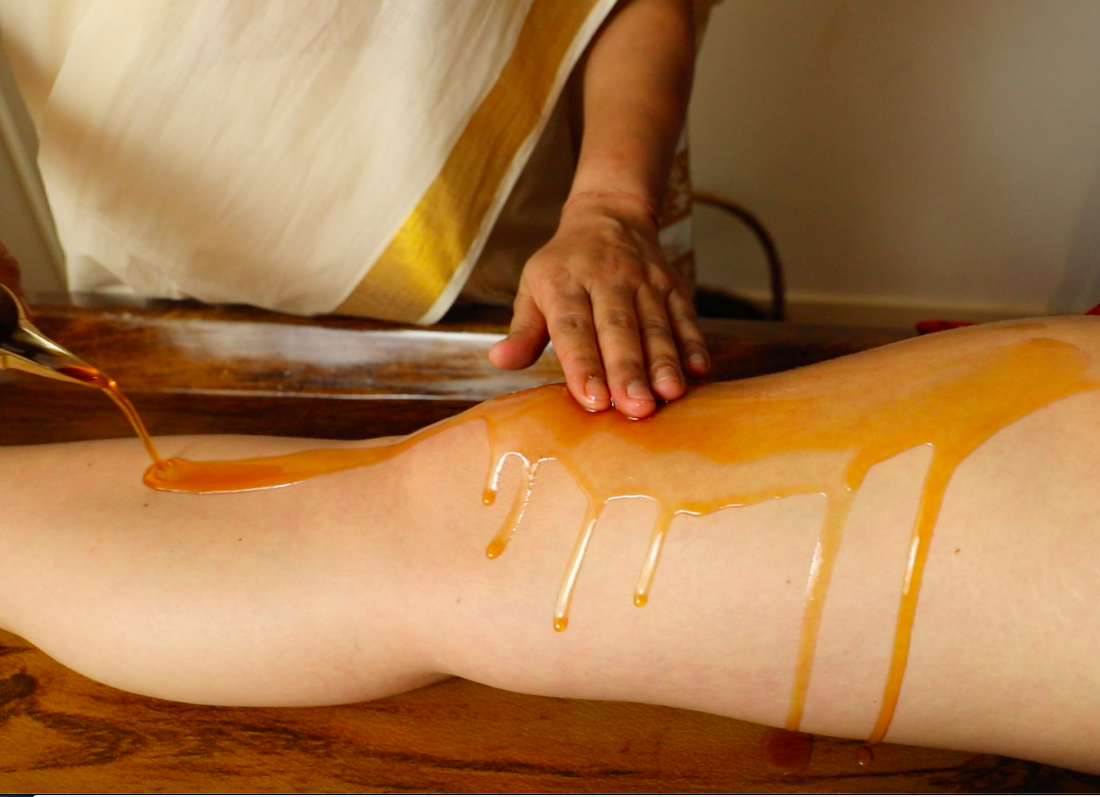
Skin health is an indicator of the inner health. Studies have indicated that the application of oil on the skin and daily massage helps in improving the suppleness of the skin. It avoids premature aging of the skin by improving blood circulation towards it.
Full body ayurvedic massage also increases the nutrition to the skin cells. The elasticity, as well as the complexion of the skin, is improved by massaging the skin daily.
Studies have also reported that the skin of the face gets brightened by Abhyanga.
Massaging the scalp and the hair with oil nourishes the roots, strengthens the hair and prevents hair fall. It also prevents baldness and graying of the hair.
Lowers Pain
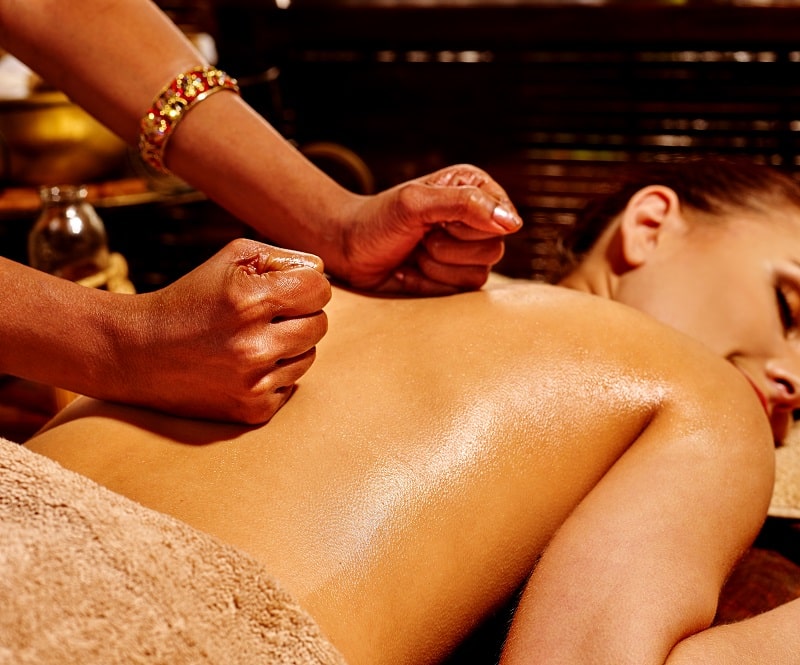
In today’s time, muscle pain and joint pain have become very common among all age groups. Full body ayurvedic massage is beneficial for individuals with musculoskeletal disorders.
Ayurvedic massage relaxes the muscles, decreases pain and stiffness and increases the mobility of the joints. Massage increases the circulation of the oxygen and nutrient-rich blood towards the muscles. This reduces soreness and fatigue of the muscles by enhancing the removal of toxins and waste products from the muscles.
An interesting clinical study observed improvements in people with spinal cord injury who underwent Abhyanga. The study further indicated that this oil massage reduced fatigue and chronic pain in affected individuals.
Management of Sleep Disorders
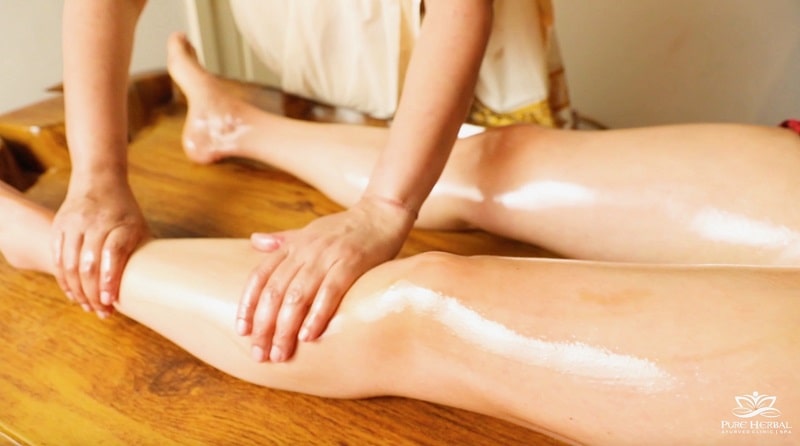
Insomnia is one of the most common sleep disorders, which results in poor quality of life.
Full body ayurvedic massage is an important procedure for the management of insomnia in addition to head massage. An interesting study found that Abhyanga eases emotional trauma through relaxation, thus it keeps the mind and the body relaxed.
This improves the quality of sleep in affected individuals. Massaging around the ears reduces the amount of time taken to fall asleep after going to bed.
During Abhyanga, endorphins and serotonin are released, which induce sleep in a short time after going to bed.
Abhyanga relieves stiffness, tightness, restrictions and spasms in the head muscle tissue. It stimulates the sensory receptors, which soothe the nerves. Such an action improves the quality and duration of sleep.
Improves Infant Growth
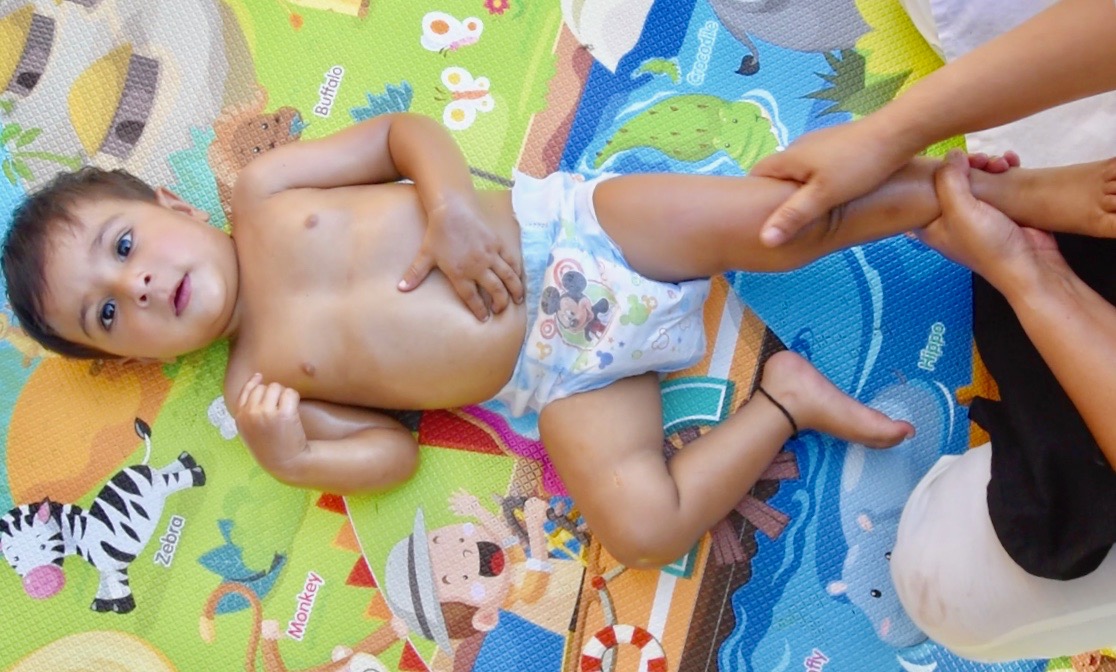
The infant period is the foundation of adult human life. Ayurveda has explained that Abhyanga is a sophisticated and delicate protocol for the infants.
Studies have found that Abhyanga in infants is a way of nourishing the mind, body and the spirit and improves the skin. However, Abhyanga needs to be avoided in medically unstable newborns and infants on a ventilator.
Read More: Ayurvedic Baby Massage
Procedure of Full Body Ayurvedic Massage
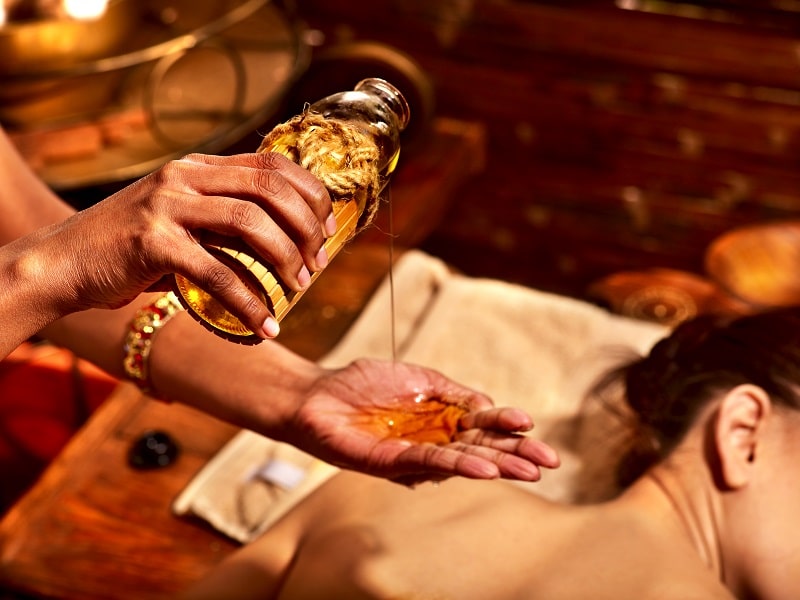
Ayurvedic Massage
- Massage is usually done in the morning.
- Massage is done in the direction of the hair with the palms.
- The massage is started by applying a small amount of slightly warm oil on the scalp. The head is then massaged gently.
- The flat surfaces of the fingers and open palm of the hands should be used for the whole massage.
- The massage is done in a circular motion to stimulate the Marma points, which influences all the other parts of the body.
- Applying oil and mildly stimulating the ears using the fingers is an important part of this procedure.
- The neck and the upper part of the back are massaged with the flat surfaces of the open palms and the fingers.
- The arms are massaged vigorously.
- Then the joints are massaged in a circular motion.
- The chest, stomach and pectoral areas are massaged gently.
- After this, the back and spine are massaged vigorously.
- The joints of the legs are massaged vigorously in a circular motion and the long bones in a straight motion.
- At the end, the feet are massaged.
- Once the whole-body massage is over, the person can steam bath.
Who Should Not Opt for Abhyagna
Abhyagna should be avoided in the following cases:
- After panchakarma detox procedures like purgation (Virechana), enema (Basti Karma), emesis (Vamana) etc. However, full body ayurvedic massage is a pre-operative procedure that requires before these purificatory therapies.
- Individuals suffering from indigestion.
- People suffering from an aggravation of kapha.
Duration of Ayurvedic Body Massage
The duration of full body ayurvedic massage is about 60 minutes.
Which Is the Best Oil for Abhyanga?
One study says that sesame oil has the ability to penetrate deep into the tissues. It is quick to spread throughout the body and is capable of reaching even the minute pores of the body.
It does not increase the kapha, helps in weight management, treats constipation, helps the body to get rid of toxins and cures all the diseases.
The medicated ayurvedic oils used in full body massage contains sesame oil as a base. The different herbs are processed in sesame oil for making ayurvedic massage oil. Each oil has different benefits that we will discuss in another article.
References
- Annetrin Jytte Basler, Pilot Study Investigating the Effects of Ayurvedic Abhyanga Massage on Subjective Stress Experience, The Journal of Alternative and Complementary Medicine, May 2011, http://doi.org/10.1089/acm.2010.0281
- Sinha, Kaushal & A. Lohith, B & Kumar Ashvini, M. (2017). Abhyanga: Different contemporary massage technique and its importance in Ayurveda. Journal of Ayurveda and Integrated Medical Sciences (JAIMS). 2. 10.21760/jaims. v2i3.8238.
- B. Kothainayagi, Dr.Sangeeta Gupta, conceptual and applied study on abhyanga (ayurvedic massage), INDIAN JOURNAL OF RESEARCH, https://wwjournals.com/index.php/pijr/article/view/531
- C, Roshy & Cherian, Anu & CT, Joseph. (2012). ROLE OF ABHYANGA (OIL MASSAGE) TO LEAD A HEALTHY LIFE. 111. 163-167. https://www.researchgate.net/publication/293531006
- Robert Walaszek, Impact of classic massage on blood pressure in patients with clinically diagnosed hypertension, Journal of Traditional Chinese Medicine, Volume 35, Issue 4, 2015, Pages 396-401, ISSN 0254-6272, https://doi.org/10.1016/S0254-6272(15)30115-1.
- Shrikrishna, Rajagopala & Raskar, Swapnil. (2015). Abhyanga in newborn baby and neonatal massage – A review. International Journal of Ayurveda and Pharma Research. 3. 5-10.

